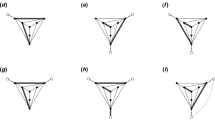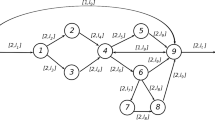Abstract
We consider a generalization of the familiar art gallery problem in which individual points within the gallery need to be visible to some specified, but not necessarily uniform, number of guards. We provide an \(O(\lg \lg {\mathrm {OPT}})\)-approximation algorithm for this multi-guarding problem in simply-connected polygonal regions, with a minimum number (\({\mathrm {OPT}}\)) of vertex guards (possibly co-located). Our approximation algorithm is based on a polynomial-time algorithm for building what we call \(\varepsilon \)-multinets of size \(O\left( \frac{1}{\varepsilon }\lg \lg \frac{1}{\varepsilon }\right) \) for the instances of Multi-HittingSet associated with our multi-guarding problem. We then apply a now-standard linear-programming technique to build an approximation algorithm from this \(\varepsilon \)-multinet finder. This paper corrects, and simplifies the analysis of, the \(O\left( \frac{1}{\varepsilon }\lg \lg \frac{1}{\varepsilon }\right) \)-time \(\varepsilon \)-net-finder described in [26], that was used to build an \(O(\lg \lg {\mathrm {OPT}})\)-approximation algorithm for the standard guarding problem in which all points within the gallery are required to be visible to at least one guard.



Similar content being viewed by others
Notes
See Appendix for a comparison of our approach with that of [26], including a discussion of the source of the difficulty with the latter.
It is a pseudopolynomial-time algorithm in that its running time may be linear in the ratio between the longest and shortest distances between two vertices.
References
Aggarwal, A.: The art gallery theorem: its variations, applications and algorithmic aspects. Ph.D. thesis, The Johns Hopkins University (1984)
Belleville, P.: Two-guarding simple polygons. In: Proceedings of 4th Canadian Conference on Computational Geometry. St. John’s, Newfoundland, pp. 103–108 (1992)
Belleville, P., Bose, P., Czyzowicz, J., Urrutia, J., Zaks, J.: K-guarding polygons on the plane. In: Proceedings of 6th Canadian Conference on Computational Geometry. Saskatoon, Saskatchewan, pp. 381–386 (1994)
Bereg, S.: On \(k\)-vertex guarding simple polygons. Computational Geometry and Discrete. \(K\hat{o}ky\hat{u}roku\), vol. 1641, pp. 106–113. Research Institute for Mathematical Sciences, Kyoto University, Kyoto (2008)
Blumer, A., Ehrenfeucht, A., Haussler, D., Warmuth, M.K.: Learnability and the Vapnik-Chervonenkis dimension. J. ACM 36(4), 929–965 (1989)
Bose, P., Lubiw, A.: Efficient visibility queries in simple polygons. Comput. Geom. Theory Appl. 23(3), 313–335 (2002)
Brönnimann, H., Goodrich, M.T.: Almost optimal set covers in finite VC-dimension. Discrete Comput. Geom. 14(4), 463–479 (1995)
Busto, D., Evans, W.S., Kirkpatrick, D.G.: On k-guarding polygons. In: Proceedings of the 25th Canadian Conference on Computational Geometry (CCCG’13), Waterloo, Ontario (2013)
Chekuri, C., Clarkson, K.L., Har-Peled, S.: On the set multicover problem in geometric settings. ACM Trans. Algorithms 9(1), 9:1–9:17 (2012)
Chvátal, V.: A greedy heuristic for the set-covering problem. Math. Oper. Res. 4(3), 233–235 (1979)
Chvátal, V.: A combinatorial theorem in plane geometry. J. Comb. Theory, Ser. B 18(1), 39–41 (1975)
Clarkson, K.L.: Algorithms for polytope covering and approximation. Algorithms and Data Structures (WADS 1993). Lecture Notes in Computer Science, vol. 709, pp. 246–252. Springer, Berlin (1993)
Deshpande, A., Kim, Taejung, Demaine, Erik D., Sarma, Sanjay E.: A pseudopolynomial time \({O}(\log n)\)-approximation algorithm for art gallery problems. In: Proceedings of the 10th Workshop on Algorithms and Data Structures (WADS 2007). Lecture Notes in Computer Science, vol. 4619, pp. 163–174. Halifax, Nova Scotia (2007)
Eidenbenz, S.: Inapproximability results for guarding polygons without holes. Lecture Notes in Computer Science, vol. 1533, pp. 427–436. Springer, Berlin (1998)
Eidenbenz, S., Stamm, C., Widmayer, P.: Inapproximability results for guarding polygons and terrains. Algorithmica 31(1), 79–113 (2001)
Even, G., Rawitz, D., Shahar, S.M.: Hitting sets when the VC-dimension is small. Inf. Process. Lett. 95(2), 358–362 (2005)
Feige, U.: A threshold of \(\ln n\) for approximating set cover. J. ACM 45(4), 634–652 (1998)
Fisk, S.: A short proof of Chvátal’s Watchman Theorem. J. Comb. Theory, Ser. B 24(3), 374 (1978)
Fusco, G., Gupta, H.: \(\varepsilon \)-net approach to sensor k-coverage. EURASIP J. Wirel. Commun. Netw. 2010, 2 (2010)
Garey, M., Johnson, D.: Computers and Intractibility: A Guide to the Theory of NP-Completeness. W.H. Freeman and Co., New York (1979)
Ghosh, S.: Approximation algorithms for art gallery problems. In: Proceedings of Canadian Information Processing Society Congress, pp. 429–434 (1987)
Ghosh, S.: Approximation algorithms for art gallery problems in polygons. Discrete Appl. Math. 158(7), 718–722 (2010)
Gilbers, A., Klein, R.: A new upper bound for the VC-dimension of visibility regions. Comput. Geom. Theory Appl. 47(1), 61–74 (2014)
Kalai, G., Matoušek, J.: Guarding galleries where every point sees a large area. Isr. J. Math. 101(1), 125–139 (1997)
King, J.: Fast vertex guarding for polygons with and without holes. Comput. Geom. 46(3), 219–231 (2013)
King, J., Kirkpatrick, D.G.: Improved approximation for guarding simple galleries from the perimeter. Discrete Comput. Geom. 46(2), 252–269 (2011)
King, J., Krohn, E.: Terrain guarding is NP-hard. SIAM J. Comput. 40(5), 1316–1339 (2011)
Kirkpatrick, D.: Guarding galleries with no nooks. In: Proceedings of the 12th Canadian Conference on Computational Geometry (CCCG’00). Fredericton, New Brunswick, pp. 43–46 (2000)
Komlós, J., Pach, J., Woeginger, G.: Almost tight bounds for epsilon-nets. Discrete Comput. Geom. 7(1), 163–173 (1992)
Lee, D., Lin, A.: Computational complexity of art gallery problems. IEEE Trans. Inf. Theory 32(2), 276–282 (1986)
Long, P.M.: Using the pseudo-dimension to analyze approximation algorithms for integer programming. Algorithms and Data Structures (WADS 2001). Lecture Notes in Computer Science, vol. 2125, pp. 26–37. Springer, Berlin (2001)
Mehlhorn, K., Sack, J., Zaks, J.: Note on the paper “K-vertex guarding simple polygons” [Computational Geometry 42(4), May 2009, pp. 352–361]. Comput. Geom. 42(6–7), 722 (2009)
O’Rourke, J.: Art Gallery Theorems and Algorithms. Oxford University Press, New York (1987). http://cs.smith.edu/~orourke/books/ArtGalleryTheorems/art.html. Accessed 26 Jan 2012
O’Rourke, J., Supowit, K.J.: Some NP-hard polygon decomposition problems. IEEE Trans. Inf. Theory 29(2), 181–189 (1983)
Plotkin, S.A., Shmoys, D.B., Tardos, É.: Fast approximation algorithms for fractional packing and covering problems. Math. Oper. Res. 20(2), 257–301 (1995)
Raz, R., Safra, S.: A sub-constant error-probability low-degree-test and a sub-constant error-probability PCP characterization of NP. In: Proceedings of 29th ACM Symposium on Theory of Computing, El Paso, pp. 475–484 (1997)
Salleh, I.: K-vertex guarding simple polygons. Comput. Geom. 42(4), 352–361 (2009)
Urrutia, J.: Art gallery and illumination problems. In: Sack, J.-R., Urrutia, J. (eds.) Handbook of Computational Geometry, pp. 973–1027. North-Holland Publishing Co., Amsterdam (2000)
Valtr, P.: Guarding galleries where no point sees a small area. Isr. J. Math. 104(1), 1–16 (1998)
Young, N.E.: Randomized rounding without solving the linear program. In: Proceedings of the 6th Annual ACM-SIAM Symposium on Discrete Algorithms. Society for Industrial and Applied Mathematics, Philadelphia, pp. 170–178 (1995)
Acknowledgments
The author acknowledges the generous support of the Natural Sciences and Engineering Research Council of Canada. The many helpful discussions with Daniel Busto and William Evans concerning multi-guarding problems are also gratefully acknowledged.
Author information
Authors and Affiliations
Corresponding author
Appendix: Remark on the Hierarchical Fragmentation Construction of King and Kirkpatrick [26]
Appendix: Remark on the Hierarchical Fragmentation Construction of King and Kirkpatrick [26]
A very similar hierarchical fragmentation (differing from ours only in the definition of \(t\), and in the level-1 fragmentation factor \(b_1\)) was described by King and Kirkpatrick [26] in developing their approximation bound for optimal \(1\)-guarding. Unfortunately, the choice of \(\alpha \) (which, together with \(t\) determines \(b_1\)) given in their Eq. (3) does not always guarantee that their Eq. (1) holds. In particular, consider the case when \(1/ \varepsilon = 2^{2^{t-1}+1}\) (so \(t = \lceil \log \log (1/ \varepsilon ) \rceil \), as specified). In this case, \(\alpha = 1/ (4t 2^{2^{t-1}+1-t})\) and so \(t \alpha 2^{2^t}\) (the bound on \(|S_{HF}|\), the size of their guard set) is essentially \(2^t \cdot 1/ \varepsilon \), which is \(\Theta ( (1/ \varepsilon ) \log (1/ \varepsilon ))\), not \(O((1/ \varepsilon ) \log \log (1/ \varepsilon ))\), as claimed in their Eq. (1).
Rights and permissions
About this article
Cite this article
Kirkpatrick, D. An \(O(\lg \lg {\mathrm {OPT}})\)-Approximation Algorithm for Multi-guarding Galleries. Discrete Comput Geom 53, 327–343 (2015). https://doi.org/10.1007/s00454-014-9656-8
Received:
Revised:
Accepted:
Published:
Issue Date:
DOI: https://doi.org/10.1007/s00454-014-9656-8




